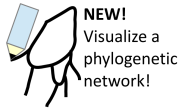
ISIPhyNC
Welcome to ISIPhyNC, the Information System on Inclusions of Phylogenetic Network Classes, which provides information about subclasses of phylogenetic networks.
This website focuses only on rooted explicit phylogenetic networks, that is directed acyclic graphs with a root (a vertex of indegree 0) and leaves (vertices with outdegree 0) which are usually labeled by distinct labels corresponding to biological taxa.
Classes of explicit phylogenetic networks
Classes of binary networks
An arrow from class A to class B means that A contains B (another version of this graph, drawn with GraphViz, is available here).
To have more information about the subclasses and the proofs of inclusion,
please follow the links in the list of subclasses below.
List of classes:
- binary
- binary 1-reticulated
- binary 2-nested
- binary 2-reticulated
- binary 3-nested
- binary 3-reticulated
- binary compressed
- binary distinct-cluster
- binary FU-stable
- binary galled network
- binary galled tree
- binary genetically stable
- binary k-nested
- binary k-reticulated
- binary leaf outerplanar
- binary level-2
- binary level-3
- binary level-k
- binary nearly stable
- binary nearly tree-child
- binary nested
- binary normal
- binary phylogenetic tree
- binary regular
- binary reticulation-visible
- binary spread-1
- binary spread-2
- binary spread-3
- binary spread-k
- binary stable-child
- binary time-consistent
- binary tree-based
- binary tree-child
- binary tree-sibling
- binary unicyclic
Classes with unbounded degree
List of classes:
- 1-nested
- 1-reticulated
- 2-nested
- 2-reticulated
- 3-nested
- 3-reticulated
- compressed
- decontracted
- decontracted-distinct-cluster
- decontracted-regular
- distinct-cluster
- FU-stable
- galled network
- galled tree
- genetically stable
- k-nested
- k-reticulated
- leaf outerplanar
- level-2
- level-3
- level-k
- nearly stable
- nearly tree-child
- nested
- normal
- phylogenetic tree
- regular
- reticulation-visible
- spread-1
- spread-2
- spread-3
- spread-k
- time-consistent
- tree-based
- tree-child
- tree-sibling
- unicyclic
Problems and properties studied on these classes
Problems
- Tree Containment: Does the input network contain the input tree on the same set of leaves?
- Cluster Containment: Does the input network contain the input subset of leaves as a softwired cluster?
- Phylogenetic Network Isomorphism: Are the two input phylogenetic networks isomorphic?
Properties
- Upper bound on the number of vertices: The number of vertices is bounded by the number of leaves.
- Unbounded number of vertices: The number of vertices is not bounded by the number of leaves.
- Completeness for reconstruction from trees: There exists a network in this class which displays all binary rooted phylogenetic trees on n leaves.
Examples of networks in these classes
- network 1
- network 2
- network 3
- network 4
- network 5
- network 6
- network 7
- network 8
- network 9
- network 10
- network 11
- network 12
- network 13
- network 14
- network 15
- network 16
- network 17
- network 18
- network 19
- network 20
- network 21
- network 22
- network 23
- network 24
About this website
This website was programmed and is maintained by Philippe Gambette. It was started during the internship of Maxime Morgado at LIGM, in June-July 2015, and also contains contributions made from Narges Tavassoli from November 2016 to January 2017.
Please contact Philippe Gambette if you have any suggestions about this website, especially about problems, properties, results or subclasses to add.
How to cite
P. Gambette, M. Morgado, N. Tavassoli & M. Weller (2018) ISIPhyNC, an Information System on Inclusions of Phylogenetic Network Classes, manuscript in preparation.
Database content
73 classes of phylogenetic networks including 35 classes of binary phylogenetic networks (defined in a total of 20 bibliographic references), 51 inclusion relationships proved directly between classes (including some found in a total of 9 bibliographic references), 24 networks (68 memberships to a class, 56 non-memberships to a class), 3 problems considered, 3 properties considered, 37 theorems proved directly (including some found in a total of 17 bibliographic references) including 26 positive results (which can be extended to subclasses) and 11 negative results (which can be extended to superclasses).

